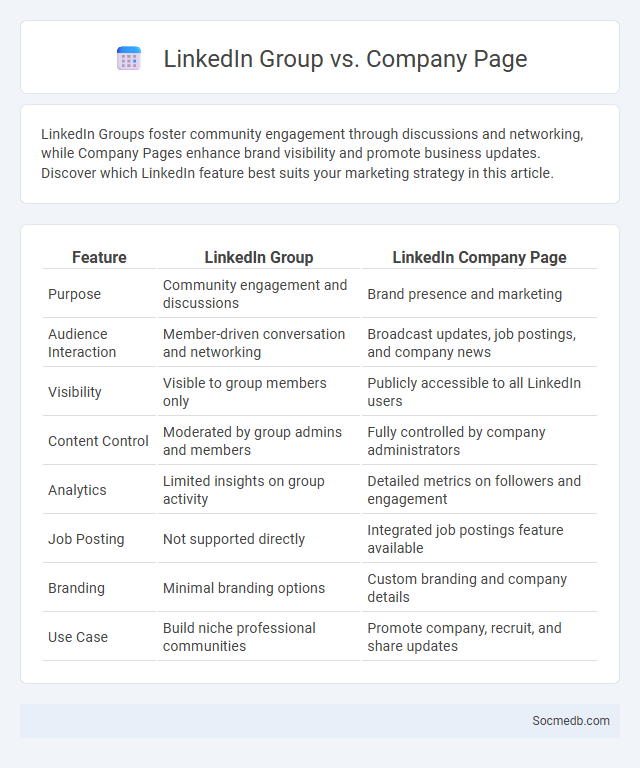
Photo illustration: LinkedIn Group vs Company Page
LinkedIn Groups foster community engagement through discussions and networking, while Company Pages enhance brand visibility and promote business updates. Discover which LinkedIn feature best suits your marketing strategy in this article.
Table of Comparison
| Feature | LinkedIn Group | LinkedIn Company Page |
|---|---|---|
| Purpose | Community engagement and discussions | Brand presence and marketing |
| Audience Interaction | Member-driven conversation and networking | Broadcast updates, job postings, and company news |
| Visibility | Visible to group members only | Publicly accessible to all LinkedIn users |
| Content Control | Moderated by group admins and members | Fully controlled by company administrators |
| Analytics | Limited insights on group activity | Detailed metrics on followers and engagement |
| Job Posting | Not supported directly | Integrated job postings feature available |
| Branding | Minimal branding options | Custom branding and company details |
| Use Case | Build niche professional communities | Promote company, recruit, and share updates |
Introduction to LinkedIn Groups and Company Pages
LinkedIn Groups provide a collaborative platform where professionals with shared interests can network, exchange ideas, and discuss industry trends in a focused environment. Company Pages on LinkedIn serve as dynamic profiles for businesses to showcase their brand, post updates, share content, and engage with followers to build a strong professional presence. Both features enhance professional networking, brand visibility, and community engagement within LinkedIn's business-oriented social media ecosystem.
Key Features of LinkedIn Groups
LinkedIn Groups offer a professional networking space where members can share insights, ask questions, and engage in industry-specific discussions. Key features include targeted group categories, moderation tools to ensure relevant and respectful content, and analytics to track member engagement and growth. Members benefit from enhanced visibility, access to exclusive content, and opportunities for collaboration with like-minded professionals.
Key Features of LinkedIn Company Pages
LinkedIn Company Pages offer essential features such as customizable profiles showcasing company information, products, and services to enhance brand presence. Advanced analytics provide data on visitor demographics, engagement metrics, and post-performance to refine marketing strategies. Employee and follower engagement tools facilitate networking, content sharing, and talent recruitment within targeted professional communities.
Audience Engagement: Groups vs Company Pages
Audience engagement on social media varies significantly between Groups and Company Pages, with Groups fostering more interactive, community-driven conversations that boost user participation and brand loyalty. Company Pages often serve as authoritative sources for brand information and updates, yet they typically generate lower engagement rates compared to the dynamic, peer-to-peer interactions found in Groups. Leveraging the strengths of both formats can optimize audience reach, combining the structured branding of Company Pages with the active, engaged community presence of Groups.
Content Strategy: Groups vs Company Pages
Your content strategy on social media should balance engagement in groups and visibility on company pages. Groups foster community interaction and targeted discussions, ideal for niche audiences and building trust. Company pages enhance brand authority, provide consistent messaging, and serve as a hub for official updates and promotions.
Networking Opportunities Comparison
Social media platforms offer diverse networking opportunities tailored to different professional and personal needs. LinkedIn excels in connecting professionals and industry peers, while Twitter facilitates real-time engagement with broader audiences and experts. You can leverage these platforms strategically to maximize your networking potential and expand your influence.
Admin Controls and Moderation
Effective admin controls and moderation on social media platforms ensure a safe and respectful community by enabling you to manage content, user interactions, and community guidelines efficiently. Advanced tools like automated filters, user reporting systems, and role-based permissions help prevent spam, hate speech, and misinformation, maintaining a positive environment. Utilizing these controls empowers you to uphold platform integrity while fostering user engagement and trust.
Analytics and Performance Tracking
Social media analytics tools provide in-depth insights into user behavior, engagement rates, and content reach, enabling businesses to refine their marketing strategies effectively. Performance tracking metrics such as click-through rates (CTR), conversion rates, and follower growth offer quantifiable data to measure campaign success. Leveraging platforms like Google Analytics, Hootsuite, and Sprout Social helps optimize posting schedules and target audiences for maximum ROI.
Best Use Cases for Each Option
Instagram excels for visually-driven content, making it ideal for brands showcasing products through photos and Stories to engage Your audience effectively. LinkedIn is best suited for professional networking, B2B marketing, and thought leadership, helping you connect with industry peers and potential clients. TikTok offers dynamic short-form video content ideal for viral marketing campaigns and reaching younger demographics through creative, relatable storytelling.
Choosing the Right LinkedIn Platform for Your Business
Choosing the right LinkedIn platform features, such as LinkedIn Pages or LinkedIn Groups, depends on your business goals and target audience engagement. LinkedIn Pages enable brands to showcase products, share company updates, and run targeted ads, enhancing B2B lead generation and brand visibility. For community building and industry networking, LinkedIn Groups foster direct interaction, enabling businesses to participate in niche discussions and establish thought leadership within their sector.
 socmedb.com
socmedb.com